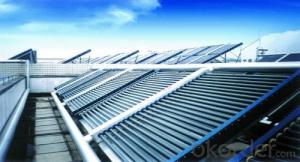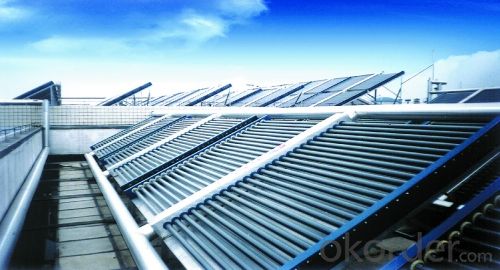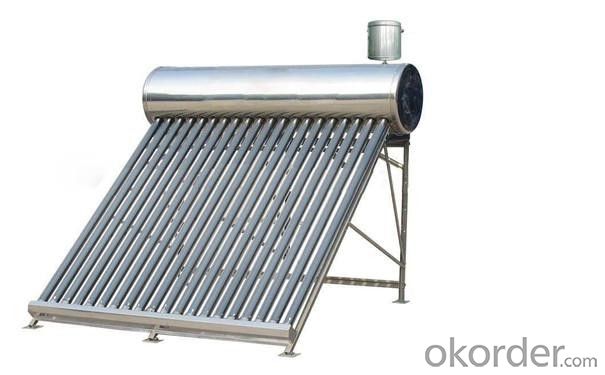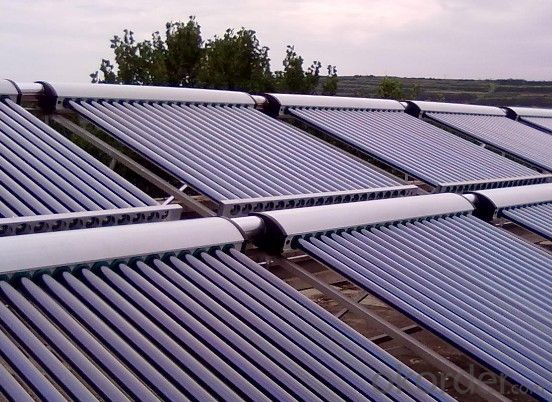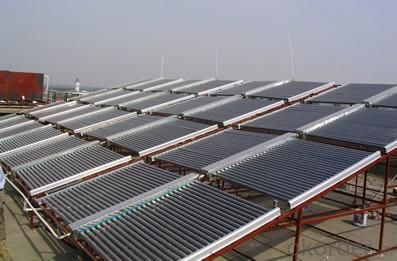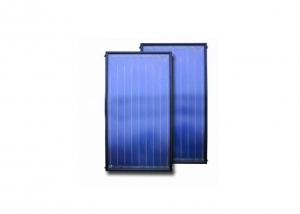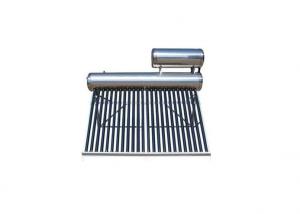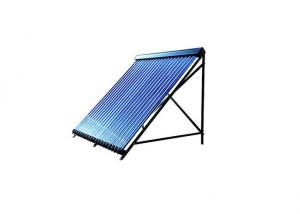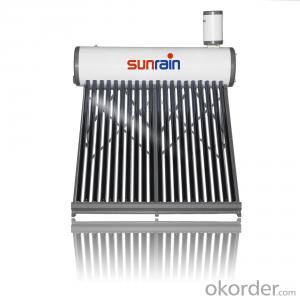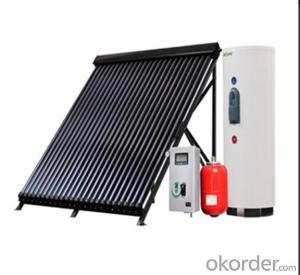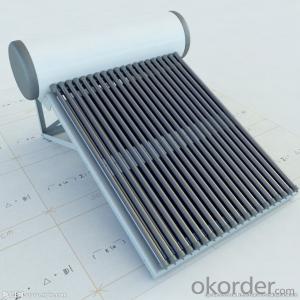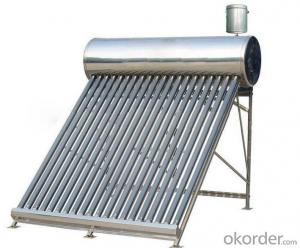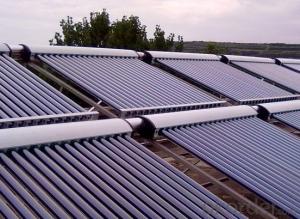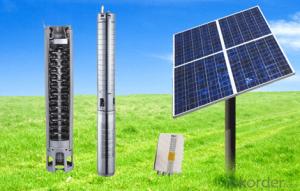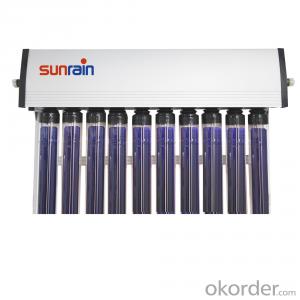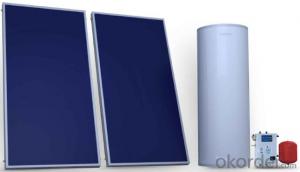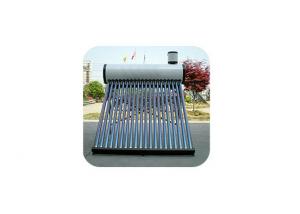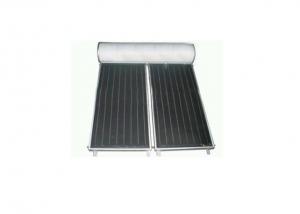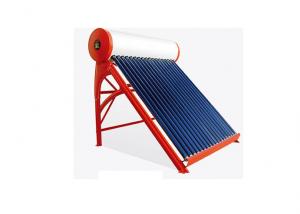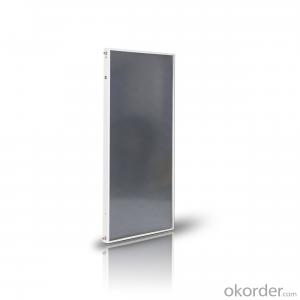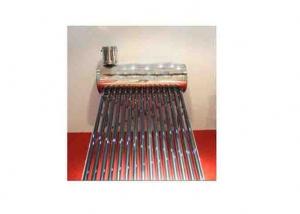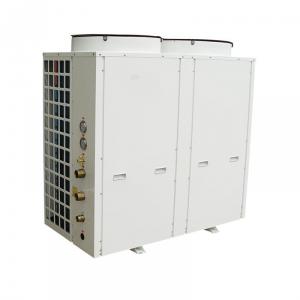Home Depot Solar Water Heater - High Quality Solar Heater for Household Use
- Loading Port:
- China main port
- Payment Terms:
- TT OR LC
- Min Order Qty:
- 10 set
- Supply Capability:
- 10000 set/month
OKorder Service Pledge
OKorder Financial Service
You Might Also Like
Solar water heaters features
1. The upright tank can make the water temperature to a high level. It can hot the water instantly
2. The tank inside the building, the hot water loses less energy than the normal one
3. The solar collector and the tank of solar water heater is separated, that makes the system combine with the building perfectly, which will reduce the sightseeing for the building and environment around
4. Back up with electric heater so that in the day without sunshine hot water can also be used
5. Can be combined with gas or electric heater
6. Max. Pressure: 12bar; Operating Pressure: 6 bar
7. It can be used for other function, such as warming
Solar water heaters working principle
1. The solar collector absorbs solar energy and transmits it to the solar water heater tank through circulation
2. When the temperature of the collector reaches the set value, the controller starts the circulation pump automatically
3. The circulation pump makes heat-conducting liquid circulate automatically
4. The heat-conducting liquid transfers heat to water by lower heat exchanger in the water tank.
5. When the temperature difference between solar collector and heat pipe solar water heaters tank doesn't reach the set value, the circulation pump will be shut automatically
6. In case the temperature of the water tank does not reach Tmax, Electric Heating Element will start to work automatically
Solar water heaters working station component:
1. Operating screen
2. Manometer
3. Pump speed adjust switches
4. Temperature difference circulation pump
5. Flow rate indicator
6. Return circuit connector
7. Safety valve
8. Expansion vessel connector9. Return circuit connector
10. Wall mounting
11. Expansion vessel:8L
12. Pressure resistance: 10 bar pressure for expansion vessel
Solar water heaters specification:
Description | solar water heaters |
Material of out manifold | 0.55mm thickness color steel/ fluorine carbon steel |
Material of inner tank | Food grade 2.0 mm thickness SUS304 stainless steel |
Tank insulating layer | 40mm 45kg/m³ high-density polyurethane foamed |
Inlet and outlet hole | Male G1'' |
Max pressure | 0.6 Mpa |
Solar collector tube | 3.3 Borosilicate glass with N/Al coating |
Thickness of glass tube | 1.6mm |
Vacuum tube tightness | P≤0.005 Pa |
Absorption | as=0.93-0.96 (AM1.5) |
Emission ratio | εh=0.04-0.06 (80C±5C) |
Idle sunning property parameters | Y=220~260m2.C/KW |
Average heat loss coefficient | ULT=0.6~0.7W/(m2.C) |
Bracket: | 2.0mm thickness aluminum alloy |
Tank weight | 75KGS |
Tank size | 560mm Dia x 1810mm Height |
Tank capacity | 300L |
Solar collector | 2pcs 58x1800x15tube solar collector |
Absorber area | 2.811 m² |
Working station | SP116 working station |
Heat exchanger length | Upper:12m, Underside:18m |
Solar water heaters details show:
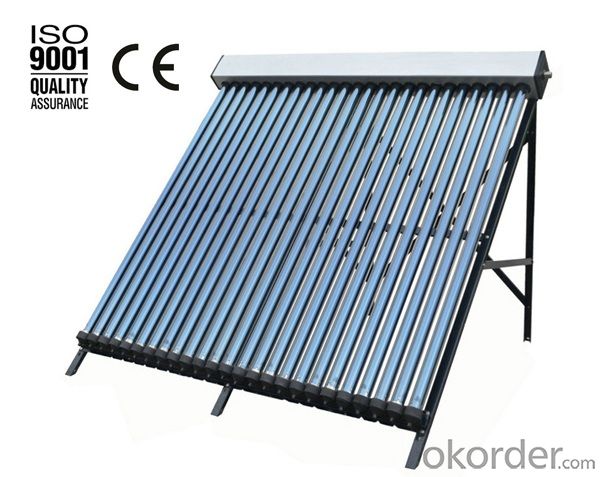
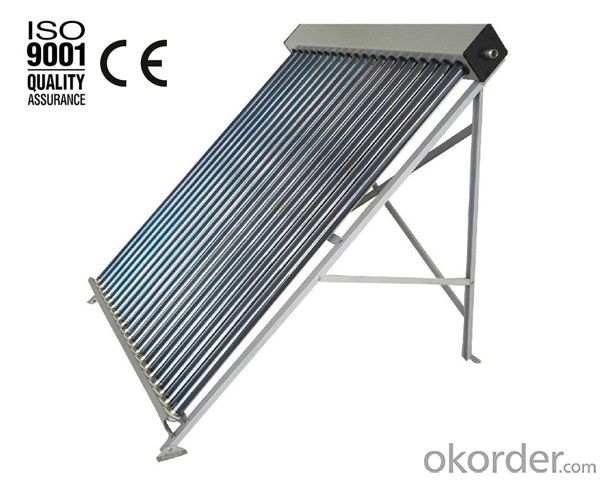
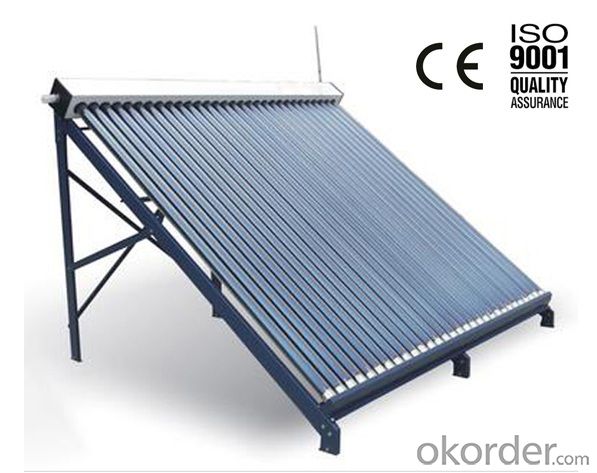
Benefits of this kind of solar water heaters:
1. Prolong the life of your existing water heater
2.Costs less than an electric, gas or oil water heater
3.No maintenance required
4.Lasts longer than a traditional hot water heater
5.Reduce your water heating costs
- Q: How much space does a solar water heater system require?
- The space required for a solar water heater system can vary depending on the size and type of the system. Generally, a typical residential solar water heater system can require anywhere from 10 to 100 square feet of space on a rooftop or open area with good sun exposure.
- Q: My solar energy has automatic water supply function, this is according to the temperature of the water, for example, the temperature is higher than a certain temperature, automatically come in cold water and in the next, because I see cloudy days, the old water dissatisfaction
- Set for the timing of water is good, water temperature control, timing Sheung Shui is generally one of the 2 election, the control board can only perform a function, always dissatisfied with your sensor is not good, is not conducive to the protection of sensors
- Q: How does a solar water heater impact home resale value?
- A solar water heater can have a positive impact on home resale value. As energy efficiency becomes an increasingly important factor for homebuyers, having a solar water heater installed can be seen as a valuable feature that sets the property apart from others. Solar water heaters use the sun's energy to heat water, reducing the reliance on traditional energy sources such as gas or electricity. This leads to lower utility bills, which is an attractive selling point for potential buyers. Additionally, as more people become environmentally conscious, having a renewable energy system like a solar water heater can be seen as a sustainable and eco-friendly feature that adds value to a home. Furthermore, many governments and municipalities offer incentives and rebates for installing solar water heaters, which can further enhance the financial benefits for homeowners. These incentives can make the investment in a solar water heater more attractive and increase the overall resale value of the property. It is important to note that the actual impact on home resale value may vary depending on various factors such as the location of the property and the overall demand for energy-efficient homes in the market. However, as the demand for green technology and energy-efficient features continues to grow, having a solar water heater can certainly contribute positively to the overall appeal and value of a home.
- Q: Are there any disadvantages of installing a solar water heater?
- Yes, there are a few disadvantages of installing a solar water heater. Firstly, the initial cost of purchasing and installing the system can be high, requiring a significant upfront investment. Additionally, the effectiveness of solar water heaters can be limited in regions with less sunlight or during cloudy days, leading to reduced efficiency. Furthermore, the size and space required for installation may pose challenges for homes with limited rooftop area. Lastly, the maintenance and repair of solar water heaters can be more complex compared to traditional water heaters.
- Q: Can a solar water heater be used in areas with low solar radiation?
- Yes, a solar water heater can still be used in areas with low solar radiation. While the efficiency of the system may be reduced, it can still provide some level of hot water heating. It is important to consider the specific requirements of the area and the capacity of the solar water heater to determine its effectiveness in low solar radiation regions.
- Q: What is the expected lifespan of the solar collector in a solar water heater?
- The expected lifespan of a solar collector in a solar water heater can vary depending on factors such as quality, maintenance, and usage. However, on average, a well-maintained and properly installed solar collector can last anywhere between 20 to 30 years.
- Q: Can a solar water heater be used in areas with limited access to a backup system?
- Yes, a solar water heater can be used in areas with limited access to a backup system. Solar water heaters use the sun's energy to heat water directly, so they do not rely on electricity or other backup systems to function. As long as there is sufficient sunlight, a solar water heater can provide hot water without the need for a backup system. This makes it a suitable and sustainable option for areas with limited access to backup systems.
- Q: Can a solar water heater be used in areas with high air pollution?
- Yes, a solar water heater can be used in areas with high air pollution. However, the efficiency of the system may be slightly reduced due to reduced sunlight reaching the solar panels. Regular maintenance and cleaning of the panels may be required to ensure optimal performance in such areas.
- Q: Can a solar water heater be used in areas with limited access to oil infrastructure?
- Yes, a solar water heater can be used in areas with limited access to oil infrastructure. Solar water heaters use energy from the sun to heat water, eliminating the need for oil or any other fossil fuels. They are a sustainable and renewable alternative to traditional water heating methods that rely on oil or gas. Solar water heaters consist of solar collectors, which absorb sunlight and convert it into heat, and storage tanks that store the heated water for later use. They can be installed on rooftops or in open spaces, making them suitable for areas with limited access to oil infrastructure. In fact, solar water heaters are particularly beneficial in areas where oil infrastructure is limited or unreliable. They provide a consistent and cost-effective source of hot water, reducing dependence on imported fossil fuels and minimizing the environmental impact associated with oil extraction, transportation, and combustion. Moreover, solar water heaters require minimal maintenance and have a long lifespan, making them a practical solution for areas with limited resources and infrastructure. They can significantly reduce energy costs and contribute to the overall sustainability of communities by utilizing clean and abundant solar energy. Overall, solar water heaters are a viable and efficient option for areas with limited access to oil infrastructure. They offer a sustainable, renewable, and cost-effective solution for heating water without relying on fossil fuels, helping to create a greener and more resilient energy system.
- Q: I have been using the solar water heater has been used for 8 years, the summer is good, but if there is no hot rain. Recently bought a new, two solar energy series method together, is a common solar water heater water tank, advanced the old, old solar water heater water into a new solar water heater, the new solar water heater outlet.Excuse me:1 this connection method is correct?2 now the problem is that this series, water supply is not normal, continuous water for 20 minutes, the water is getting smaller and smaller, to no water. There is water in the solar energy3 the best way is to link or even say, the installation of solar and even the water temperature is not the same, sometimes hot and sometimes cold, is it?
- The electric auxiliary power vacuum tube solar water heater is very low, control is not good, can increase the volume of water heater a floor type chamber shape at the outlet of the solar water heater, when the temperature is low by manual electric auxiliary heating, heating power from the general 2.4/3.6/ 4.8KW.
Send your message to us
Home Depot Solar Water Heater - High Quality Solar Heater for Household Use
- Loading Port:
- China main port
- Payment Terms:
- TT OR LC
- Min Order Qty:
- 10 set
- Supply Capability:
- 10000 set/month
OKorder Service Pledge
OKorder Financial Service
Similar products
Hot products
Hot Searches
Related keywords
